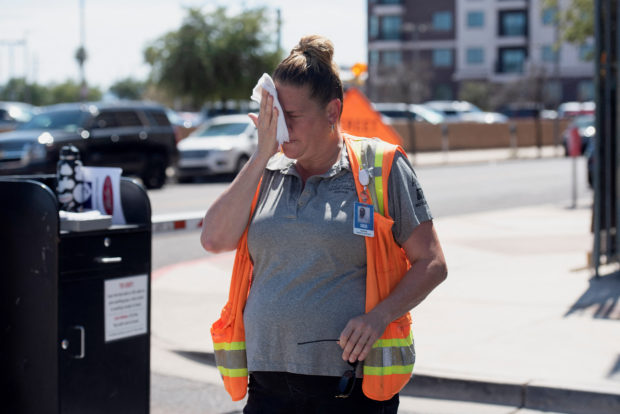Explainer: What is behind the heatwaves affecting the United States?

Vangie Jacobo wipes her face with a wet rag while working outside in 106 degree heat in Phoenix, Arizona, U.S. July 23, 2022. REUTERS
Virtually all the contiguous United States experienced above normal temperatures in the past week, with more dangerously hot weather forecast.
The U.S. heat wave followed record heat that killed hundreds if not thousands of people and sparked wildfires in Europe.
Following is an explanation of what is causing the heat waves, according to scientists.
What is a heatwave?
A heat wave has no single scientific definition. Depending on the climate of a region, it can be determined by a certain number of days above a specific temperature or percentile of the norm.
Arctic warming and jet stream migration
The Arctic is warming three to four times faster than the globe as a whole, meaning there is ever less difference between northern temperatures and those closer to the equator.
Article continues after this advertisementThat is resulting in swings in the North Atlantic jet stream, which in turn leads to extreme weather events like heat waves and floods, according to Jennifer Francis, senior scientist at the Woodwell Climate Research Center.
Article continues after this advertisementHeat domes
Warmer oceans contribute to heat domes, which trap heat over large geographical areas. This weekend the heat dome is stretching from the southern plains of the Oklahoma/Arkansas area all the way to the eastern seaboard, according to the U.S. Weather Prediction Center.
Scientists have found the main cause of heat domes is a strong change in ocean temperatures from west to east in the tropical Pacific Ocean during the preceding winter.
“As prevailing winds move the hot air east, the northern shifts of the jet stream trap the air and move it toward land, where it sinks, resulting in heat waves,” the U.S. National Oceanic and Atmospheric Administration says on its website.
El Niño and La Niña
Every few years, the climate patterns known as El Niño and, less frequently, La Niña occur. El Niño brings warm water from the equatorial Pacific Ocean up to the western coast of North America, and La Niña brings colder water.
At present, La Niña is in effect. Because summer temperatures trend lower during La Niña, climate scientists are concerned about what a serious heat wave would look like during the next El Niño, when even hotter summer weather could be expected.
Human-influenced climate change
Climate change caused by the burning of fossil fuels is a global phenomenon that is certainly playing a role in what the United States is experiencing, scientists say.
“Climate change is making extreme and unprecedented heat events both more intense and more common, pretty much universally throughout the world,” said Daniel Swain, climate scientist at UCLA.
“Heat waves are probably the most underestimated type of potential disaster because they routinely kill a lot of people. And we just don’t hear about it because it doesn’t kill them in, to put it bluntly, sufficiently dramatic ways. There aren’t bodies on the street.”
Francis, of the Woodwell Center, said with climate change the world is seeing changing wind patterns and weather systems “in ways that make these heat waves, like we’re seeing right now, more intense, more persistent, and cover areas that just aren’t used to having heat waves.”
Alex Ruane, researcher at Nasa’s Goddard Institute for Space Studies, said as the world warms, “it takes less of a natural anomaly to push us into the extreme heat categories. Because we’re closer to those thresholds, it’s more likely that you’ll get more than one heat wave at the same time. We’re seeing this in the United States.”
RELATED STORIES
Record-breaking heatwave bakes Americans
Americans endure ‘dragon’s breath’ heat wave, set to last into next week
No relief as heatwave in US moves east
Floods, fires, heatwaves: US struggles with climate catastrophe